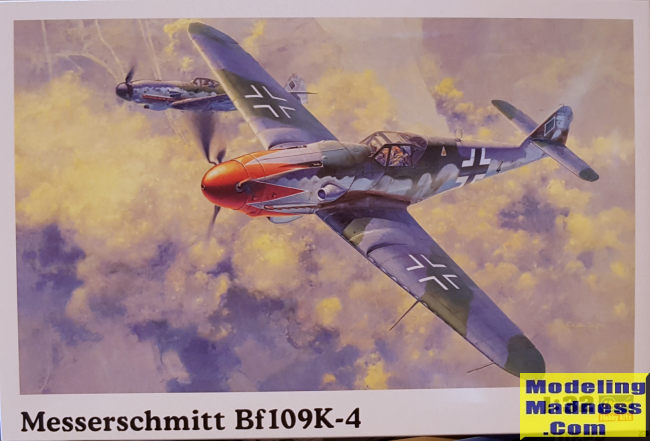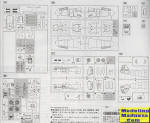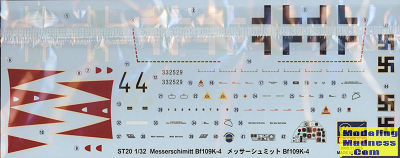
Hasegawa 1/32 Bf-109K-4
| KIT #: | 08070 |
| PRICE: | 4200 yen SRP |
| DECALS: | Two options |
| REVIEWER: | Scott Van Aken |
| NOTES: | 2003 release. Base boxing |

| HISTORY |
The Bf 109K was the last of the series to see operational duty and the last in the Bf 109 evolutionary line. The K series was a response to the bewildering array of series, models, modification kits and factory conversions for the Bf 109, which made production and maintenance complicated and costly – something Germany could not afford late in the war. The RLM ordered Messerschmitt to rationalise production of the Bf 109, consolidating parts and types to produce a standard model with more interchangeable parts and equipment; flaws in the design of the airframe were also to be remedied. Work on the new version began in the spring of 1943 and the prototype was ready by autumn. Series production started in August 1944 with the K-4 model, due to changes in the design and delays with the new DB 605D powerplant. The K-4 was the only version to be mass-produced.
Externally the K series could be identified by changes in the locations of the radio equipment hatch, which was moved forward and to a higher position between frames four and five and the filler point for the fuselage fuel tank, which was moved forward to a location between frames two and three. The D/F loop was moved aft to sit between frames three and four on the fuselage spine and a small circular plate above the footstep on the port side of the fuselage was deleted. The rudder was fitted as standard with a Flettner tab and two fixed tabs although some rare examples were not fitted with the fixed tabs. All K-4s were to be fitted with a long retractable tail wheel (350 mm × 135 mm (13.8 in × 5.3 in)) with two small clamshell doors covering the recess when the tail-wheel was retracted.
The wings featured the large rectangular fairings for the large 660 mm × 190 mm (26.0 in × 7.5 in) main wheels. Small wheel well doors, originally planned for the G series, were fitted to the outer ends of the wheel bays, covering the outer wheels when retracted. These doors were often removed by front-line units. The radio equipment was the FuG 16ZY with the relocated main swept-forward radio antenna under the port wing from the G-10 being carried through as the standard for the K-series airframes. The FuG 25a Erstling IFF system, as well as the FuG 125 Hermine D/F equipment were also fitted. Internally, the oxygen bottles were relocated from the rear fuselage to the right wing. Flettner tabs for the ailerons were also to be fitted to serial production aircraft to reduce control forces but were extremely rare, with the majority of the K-4s using the same aileron system as the G series.
Armament of the K-4 consisted of a 30 mm (1.2 in) MK 108 engine-mounted cannon (Motorkanone) with 65 rounds and two 13 mm (0.51 in) MG 131s in the nose with 300 rpg, although some K-4s were fitted with the MG 151/20 as the Motorkanone. While the 30mm canon were capable of blowing the tail section off a standard Allied fighter with one hit and bringing down a B-17 with two or three, they were prone to jamming while maneuvering.
| THE KIT |
 If
you have seen the earlier Bf-109G-6 kit, then this one will be somewhat familiar
as it uses several of the same sprues (wings, landing gear, and such. However,
there are two new sprues that contain new fuselage bits, those items peculiar to
the K and an addition to the clear sprue for the new Erla canopy.
If
you have seen the earlier Bf-109G-6 kit, then this one will be somewhat familiar
as it uses several of the same sprues (wings, landing gear, and such. However,
there are two new sprues that contain new fuselage bits, those items peculiar to
the K and an addition to the clear sprue for the new Erla canopy.
Starting with the cockpit, it appears Hasegawa did not provide the larger and differently shaped cannon housing for the 30mm engine mounted gun. You also have to sand off the detail from the inside right fuselage half to fit the proper side panel for the K. The kit does provide a pilot for those who want one and those who don't should source a seat harness.
Unlike the earlier kits, the fuselage is split just behind the cockpit. This is to allow the use of a different rear fuselage section for the Bf-109G-10. One inserts the cockpit assembly from underneath after the fuselage has been assembled. Note that you have the option for decals for the instrument panels if you wish. Once those are installed, the small fuselage center section is attached along with the wing spars.
wings are upper and lower halves that require the coolant radiators to be installed before gluing together. You also have to square off the wheel well openings and open holes in the upper wing for the wheel fairings. These are simple to attach and required as the K had wider wheels. Prop is the usual separate blades with a polycap installed to ease attachment in the later stages of construction. There is an upper cowling piece and a forward piece that includes the prop shaft. Exhaust are installed from the outside so can be left off to ease painting.
After attaching the supercharger intake, the landing gear are assembled. These are then installed along with the inner and outer wheel doors. The oil cooler is a four piece assembly that is then attached to the opening in the lower cowling. An insert for the shell ejector chutes is next. In the back, one attaches the tailplanes and the tail gear.
The kit has separate slats, flaps, and radiator output
flaps. These are attached. The parts are molded in the delpoyed position.
Windscreen and canopy are separate. The canopy is designed to be displayed open
so if you want it closed, a bit of trimming will be needed. Last are the various
radio antennas and the prop. The K generally did not fly with a drop tank so
none is provided.

Instructions are quite good with the usual Gunze paint references. The two markings options are nearly identical with one being the box art plane in RLM 83/75/76 with the other having no aircraft number and in RLM 83/81/76. For both options the RLM 76 can be that greenish shade that some call RLM 84. I recommend aftermarket if you don't want to do the box art plane. Decals are nicely printed and are the more modern ones where the white is actually white.
| CONCLUSIONS |
For several years, Hasegawa had the 1/32 Bf-109 market pretty well covered. Recently Trumpeter has done a series of these planes, but I've not seen one so cannot comment on it. Revell has done a G-6 and G-10. While they are very nice and less expensive, they are also more detailed and are more parts intensive. I don't know if they will do a K-4, but I'd be surprised if they do not. Meanwhile this one is still very nice and though may be a bit difficult to find, since it is a basic boxing, you know it will be reissued.
| REFERENCES |
https://en.wikipedia.org/wiki/Messerschmitt_Bf_109_variants#K-4
August 2020 Copyright ModelingMadness.com If you would like your product reviewed fairly and
fairly quickly, please
contact
the editor
or see other details in the
Note to
Contributors.
Back to the Main Page
Back to the Review
Index Page
Back to the Previews Index Page